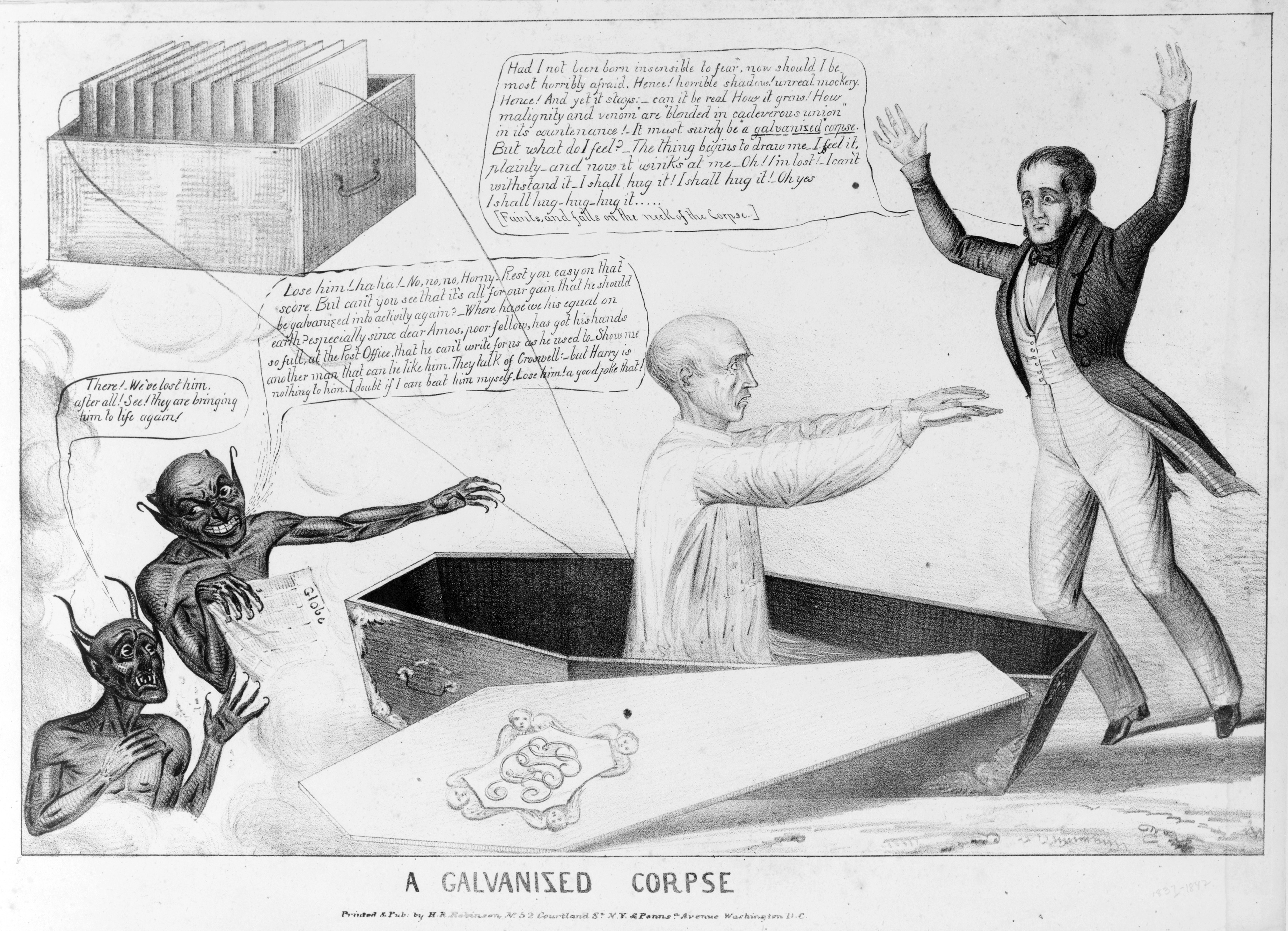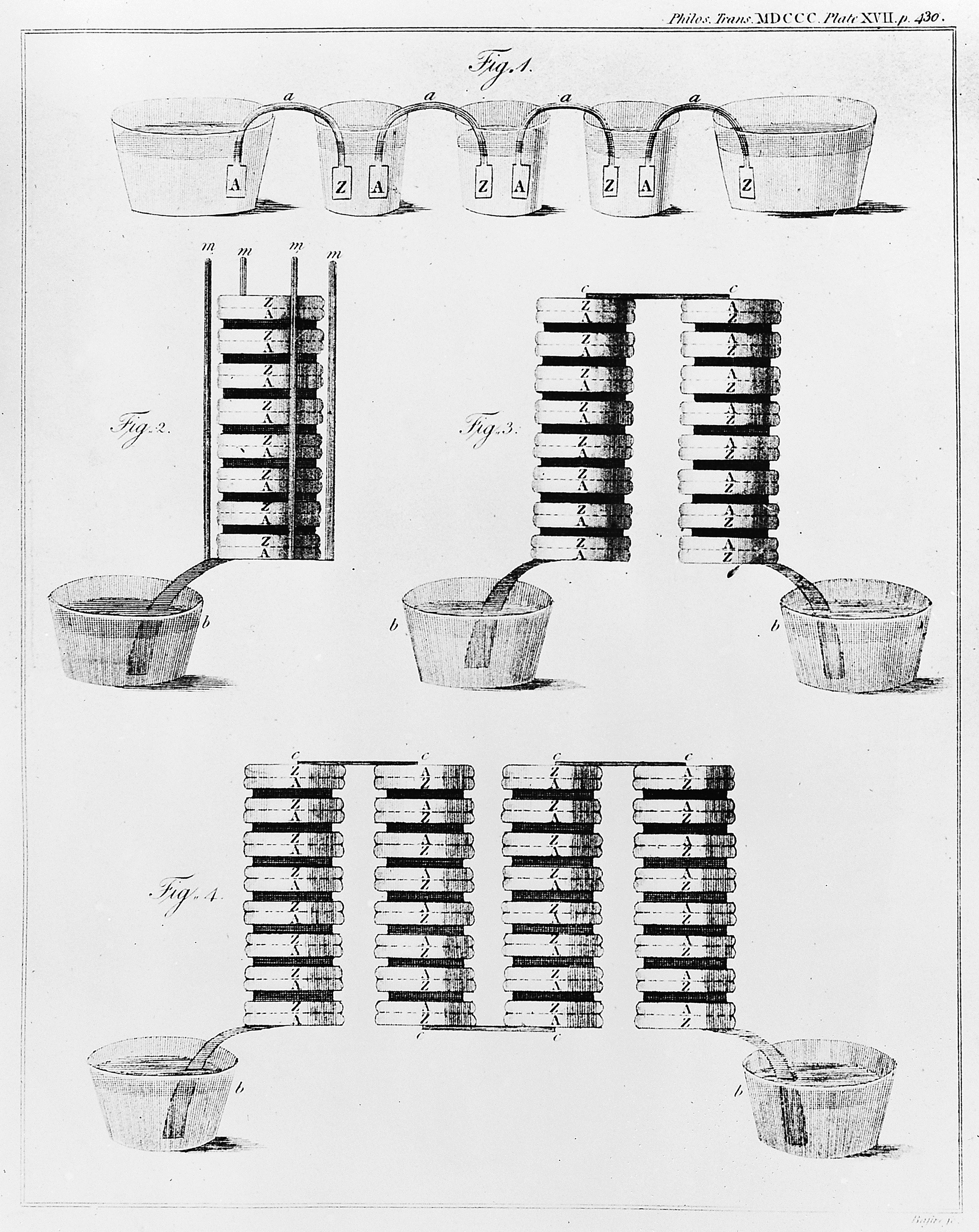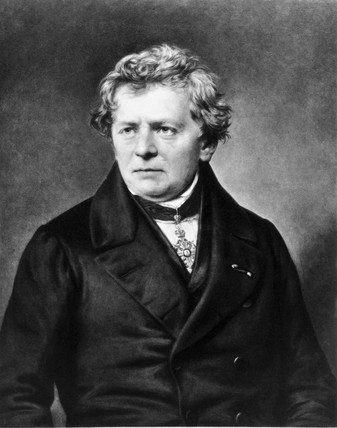Relay history: galvanism

Last time we missed the description of several decades of the history of the electric telegraph. Demonstrations of his work were exciting, he was a promising wonder, but he had yet to prove his suitability as a practical tool. But by the 1830s, electricians still made several critical discoveries that made the version of the electric telegraph known to us possible. It all started with a frog.
Animal electricity
In November 1780, Luigi Galvani , a physician and anatomist from the University of Bologna, dissected a frog with his scalpel with an ivory handle. Not far from him, his assistant was playing with an electric car (with what we would call an electrostatic generator). Suddenly, the frog's paw twitched. Galvani was amazed - did he really hit the nerve? He did several experiments and found out that the convulsions occurred only when the electric machine was sparkling, while his finger was touching the metal blade of the scalpel that the frog was touching at that moment.
Natural philosophers at that time already knew that animals can produce electricity. Electric stingrays [the scientific name of the order lat. Torpediniformes comes from the word torpere - “to be in a daze” - approx. transl.] and their ability to de-sensitize fish and man have been known since ancient times and are described by Aristotle. But the source of their energy for thousands of years was unknown. By the 18th century, some electricians began to suspect that their impact was electric when they saw the same numbness effect that a leyden jar had. A series of experiments conducted in the 1770s, convincingly proved that the slope shocked living creatures with electric shock.
')

But the experiments of Galvani led to more solid conclusions: all animal life is in a sense based on electricity. "Electricity was the greatest life force through which definitions of understanding and the dictates of the will were transmitted from the brain organs to the submissive members of the body." This connection, established by the discoveries of Galvani, conquered the whole of Europe, and the most famous of the results of this hobby was the novel "Frankenstein, or Modern Prometheus" Mary Shelley.
But for our purposes, the most important thing is that Galvani opened six years later. Galvani's nephew was hanging frogs on metal hooks hanging from the balcony outside his uncle's laboratory, and he discovered something strange. When the hooks touched the railing, the frogs began to have constant convulsions, just like from the stimulation of electric sparks. Senior Galvani first swept away this anomaly, but then found that by simultaneously touching different metals in frogs, for example, iron, copper or brass, one could achieve even greater effect. This constant electrical current, whose cause was not yet clear, was called galvanism.

Experimental Galvani Apparatus
Galvani believed that he discovered "animal electricity" - that the metal connected two separate reservoirs of electrical fluid in the muscles and nerves, allowed it to flow and led to the activity of the nerves. His compatriot Alessandro Volta thought otherwise. Volta, a professor of physics at the University of Pavia, not far from Milan, believed that the cause of the flow of electricity was metal, not an animal, and set out to prove it.
But so far, the only tool capable of detecting this “weak electricity” from contact with metal was the frogs and human language. To prove his point, Volt needed a sensor of non-animal origin. He turned to the recently invented William Nicholson, the English natural philosopher, the "doubler." By turning the isolated brass discs next to each other, the doubler could turn a small initial charge into a large one. Using a doubler, Volta was able to build up weak electricity from a metal contact to such a state that he could detect with a conventional electrometer, and refuted the Galvani hypothesis. More interestingly, he discovered that after a sufficient number of turns, the doubler itself began to generate a detectable amount of electricity, even without the need for an initial charge.
Soon Volta was already experimenting with stacks of paired discs from different metals. He was inspired by another work by Nicholson, which described the preparation of an electric organ of a stingray. Nicholson found in this organ a mass of columns, each of which consisted of a stack of small circular layers. Nicholson believed that it was possible to build a machine that simulated the work of this body, possibly with the help of mica films. Volta agreed with the principle of action, but not with the materials. By 1799, he stopped on stacks of zinc discs, paired with copper, and pieces of leather or cardboard saturated with sea water, laid between the discs of each pair. This device could generate significant and constant electrical current. The second variant of the scheme, which he called the "crown of cups", consisted of cups with acid or salt water, connected by plates consisting of two different metals, welded together.

After Volta announced his discovery at the Royal Society in London in March 1800, it spread throughout Europe at the speed of fire. Already by May, the Volta device had led to an important discovery — decomposition of water by means of electricity — which was made by none other than Nicholson, who had worked with the surgeon Anthony Carlyle. In English, it was called "battery", a term already used to describe a combination of Leyden jars.
By this time, Galvani had already passed away. In 1797, Napoleon reorganized northeastern Italy into the Tsizalpinsky Republic , a subsidiary satellite state of the First French Republic. Volta took a new order of things, received the Order of the Legion of Honor, became the count and senator. Galvani, refusing to swear allegiance to the Republican government, was expelled from his post at the university and died in poverty a year later. But the study of galvanism flourished and expanded - with the help of a Volt battery.
Electromagnetism
The battery allowed for the first time to carefully examine the electricity in motion. Leiden banks or other static devices produced one instantaneous discharge. But now the researcher could set up a battery, connect it with any experimental device, and calmly study the effects of dynamic electricity.
Soon, researchers applied a new device to research the relationship of electricity and magnetism. Since ancient times, some have suspected a deep connection between these "occult" attracting forces, but there were mysterious differences between them. For example, electrified amber attracted any light object, while magnetite attracted only iron.
In the 17th century, new testimonies appeared when philosophers noticed reports on how lightning magnetized iron objects (like crosses on churches' belltowers) and turned on ship's compasses. Ben Franklin showed that Leyden banks could magnetize or reverse the polarity of a magnet - and this was not surprising, since by that time he and other researchers had shown that lightning was electrical in nature. But the evidence was not straightforward. What was the real connection between electricity and magnetism? By the end of the XVIII century, opinions were divided. Some believed that the apparent similarity was random, others were confident that both phenomena were explained by one original cause.
After the discoveries of Galvani and Volta, the philosophers began to study the possible interactions of galvanism and magnet. The most important results appeared in 1820, when Hans Christian Oersted , a professor of physics at the University of Copenhagen, noticed during a lecture that a galvanic current deflects a magnetized arrow. After subsequent experiments, he published his discoveries - the current flowing from north to south over the needle, pushes its end to the west; the current beneath it is to the east.
When André-Marie Ampere read about this discovery in Paris, he immediately began to delve into this question. Ampere was a professor of mathematics at the Polytechnic School of Paris. This higher school of engineers, like the optical telegraph, was the product of the French Revolution, and was supposed to be produced by military engineers who were easily guided in advanced mathematics and physics. Oersted saw the effect of the phenomenon, and Ampere was looking for its root cause, using considerable skills in mathematics and experimental physics. He managed to eliminate the influence of the Earth’s magnetic field on the experiment by gluing together two differently directed magnetized needles. He found that such a double needle forms a perfectly right angle with the wire. Interested in this, he advanced the theory that magnetism is caused by tiny closed electric currents flowing at a right angle to the axis of the magnet, directed from north to south.
Over the next ten years, such a model has proven itself perfectly - other scientists began experimenting with spiral coils of wire to simulate these circular currents. The first was his colleague, Francois Arago , who showed that a needle could be magnetized using such a coil.
A few years later, William Sturgeon improved the result of Arago. He tried to achieve bright and visual manifestations of electromagnetic forces with a small battery, in order to make it easier for him to demonstrate electromagnetic phenomena to students and the interested public. Then even for small magnetic effects, visible only to observers standing nearby, it was required to obtain a huge amount of galvanic energy with the help of huge, expensive and difficult to maintain batteries.
Sturgen discovered that if you wrap a wire around a varnished iron rod and attach it to a small battery, you can make a powerful electromagnet that retains its magnetic properties while an electric current flows through the wire. The magnet became even stronger if you bend the rod in the form of a horseshoe - then he could lift a weight of up to 4 kg.

Joseph Henry, a teacher at Albany, New York, tracked the work of European physicists on electricity and magnetism through journals such as Annals of Philosophy, where Sturgeon published a description of his electromagnet.
Henry also tried to build improved experimental equipment for pedagogical demonstrations, but he believed that he could surpass Sturgeon, bringing to perfection the model of Ampere closed currents. Henry created a hybrid of Sturgen electromagnet and Julian Schweiger's “multiplier”, which used a tightly wound wire in silk insulation to significantly enhance the effect of the Oersted experiment.

Schweiger multiplier, later called galvanometer
The use of silk-insulated wire allowed Henry to tightly wind the wire around the iron core, without risking a circuit, and it was better to get close to the model of Ampere closed currents than Sturgeon’s poorly wound spiral did. After such an improvement, he discovered that he could lift hundreds, and then thousands of kilograms with a conventional battery.

The ability of electricity to generate magnetism and attract metal — something that had long been suspected, then Oersted proved it and perfected his followers — would prove to be extremely important for subsequent creators of the electric telegraph.
Contour theory
During this period, it was not so difficult to imagine a new type of telegraph using a galvanic battery as an energy source and an electromagnetic effect as a detector. Ampere himself pointed to this as early as 1820.
By 1824, Peter Barlow, a renowned professor of mathematics at the Royal Military Academy near London, decided to study whether the telegraph described by Amper could work over long distances. To his disappointment, he discovered that the strength of the electromagnetic effect fell sharply even at such a short distance as 60 meters, which made him convinced that the electromagnetic telegraph had no practical application. Thanks to Barlow's reputation, this was enough to stop the experiments with the telegraph in England for more than a decade.
Why did some experiments with the electric telegraph fail as much as Barlow did, and others (like Francis Ronald) successfully worked with kilometer-long wires? Scientists needed an intelligent platform, a model for understanding electricity in motion, which would determine which device would work and which one would not.
And here comes Joseph Henry again. Experimenting with electromagnets in the late 1820s, he discovered that at some point the loss of current strength due to the length of the wire exceeded all attempts to add new coils around the core. This in itself confirmed the findings of Barlow.

Joseph henry
But his experiments went further. He first discovered that by dividing a long wire into several wires, each of which was wrapped around an iron core, and then separately connected to a battery — we would call parallel circuits — it could bypass restrictions and create extremely powerful electromagnets. Then he went back to his magnet with one wire and tried to connect it with another battery. Instead of a single cell of two large metal plates immersed in acid, he used a wooden trough with 25 small cells connected in series with each other. To his surprise, he found that this option lifted even more weight, being connected to a wire 300 m long, than a magnet directly connected to a battery!
Intuitively, he guessed that two different properties of electricity, quantity and intensity, played the role. A quantitative battery with one large cell and a quantitative magnet wrapped with several wires gave a great deal of mechanical power. An intense battery with many small cells along with an intense magnet with a coil from one wire, on the contrary, perfectly transmitted the electromagnetic effect over long distances. Henry was well aware of the practical implications of his work, noting in his work that it "is directly applicable to Mr. Barlow's project to create an electromagnetic telegraph."
In place of Henry, it would not be very polite to simply declare that he refuted Barlow, but he showed just that - he held a demonstration at the Albany Academy, where he managed to ring the bell, passing electricity from an intense battery over a two and a half kilometer wire. His model also explained why Ronald's telegraph worked at long distances — his friction electrostatic generator was inherently a high power device.
And although he did not recognize this, until he went to a foreign tour in 1837, Henry’s intuitive model was already thoroughly mathematically described by Georg Om , a Bavarian born who taught physics and mathematics in Prussia at the time.

Om, combining thorough experiments with mathematical imagination, carefully examined the power of various circuits, measuring it with Schweiger multiplier (by that time it was usually called a galvanometer). He concluded that the strength of the current (Ströme — the amount, as Henry called it) in the circuit depends on its voltage (Spannung — intensity in terms of Henry) divided by its “reduced length” (that is, reduced to a standard wire).
The Ohm contour model was much more complicated than the Henry model, and was published 4 years before it, in 1827. This publication, in fact, should have made Henry's publication useless. But Ohm’s work was very poorly accepted in Prussia; therefore, she did not receive wide popularity in the scientific world until the 1840s. Moreover, unlike Ohm, Henry presented his findings as a solution to the problem of long distances for the telegraph. Then it was not obvious that this solution was concealed in Ohm's mathematics. Therefore, the analysis of the quantity and intensity from Henry had a decisive effect on the development of the telegraph.
Last mile
The battery and the new kind of galvanic electricity generated by it transformed the work on the telegraph. It was a new source of electricity, more reliable and simpler than electrostatic machines, and it could be used in practice. She also greatly facilitated experiments with electricity, which made it possible to discover electromagnetism and better understand the contours.
Early telegraph detectors depended on the chemical effects of electricity or on its relatively weak attractive force — it could only lift a piece of paper. The electromagnet turned electrical energy into a coarse mechanical force, opening up more flexibility in the design of telegraph equipment. Henry and Omagh's current theories talked about which equipment is worth waiting for success, and with which - no.
For the construction of the electromagnetic telegraph appeared all the key ideas. It was necessary to wait for the people possessing will and resources to collect all this and to transform into useful system .
What to read:
• John J. Fahie, A Year of Electric Engineering 1837 (1974 [1884])
• Watt to Albert Einstein (2010) • Bruce J. Hunt, Pursuing Power and Light.
• Guilliano Pancaldi, Volta: Science and Culture in the Age of Enlightenment (2003)
Source: https://habr.com/ru/post/370545/
All Articles